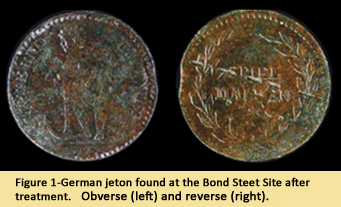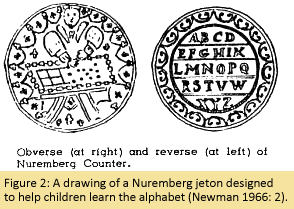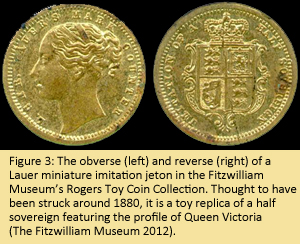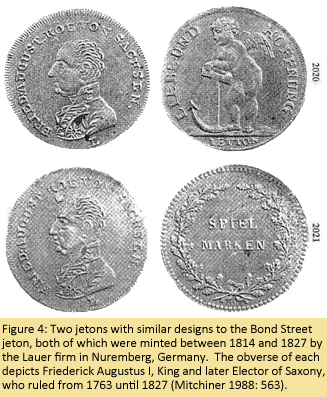The Bond Street German Jeton, and a
Very Brief History of Funny Money
December 2012
By Heather Rardin, MAC Lab Intern

 A German jeton (Figure 1) was excavated at the Bond Street Site in Baltimore, Maryland in late 1984. Leased by Edward Fell in the latter half of the 18th century, the site's functions included a lumber yard, a coffee house, and a laundry operation. The site was also the residence of Captain George Wells and his family members from 1779 to 1787 (Anonymous 2001).
A German jeton (Figure 1) was excavated at the Bond Street Site in Baltimore, Maryland in late 1984. Leased by Edward Fell in the latter half of the 18th century, the site's functions included a lumber yard, a coffee house, and a laundry operation. The site was also the residence of Captain George Wells and his family members from 1779 to 1787 (Anonymous 2001).
Long before the dawn of modern calculators, items such as seeds and pebbles were used to represent numerical values and to provide people with visual aids to help them perform simple calculations. In the 13th century, the French introduced counting pieces called “jetons” that looked like coins. The term "jeton" came from the French word "jeter- "to throw"- because they were commonly tossed onto a counting board. The idea spread to the rest of Europe, and thus counting boards and jetons became the Western counterpart of the abacus (Newman 1966).

In the 16th century, two clever minting masters from Nuremberg, Krauwindel and Schultes, designed special jetons to use as teaching tools (Figure 2). Their handiwork was ultimately a success and sold well (Newman 1966). In the two centuries that followed, people began to use jetons less often as mathematical tools. German jetons were sold as accompaniments to popular board, card, and dice games (Aschoff 2009). More and more jetons were marked with the inscription "spiel marke/spiel marken", or "game/play money", by the early 19th century (Mitchiner 1988).
 In the 19th century, the Lauer firm of Nuremberg produced miniature imitations of real currency from fourteen different European countries (Figure 3). In order to discourage people from using them in place of real money, the Lauer firm and others placed manufacturer's marks on many of these toy miniatures. The imitations enjoyed such popularity in Europe that they became favorite collectible items (Aschoff 2009).
In the 19th century, the Lauer firm of Nuremberg produced miniature imitations of real currency from fourteen different European countries (Figure 3). In order to discourage people from using them in place of real money, the Lauer firm and others placed manufacturer's marks on many of these toy miniatures. The imitations enjoyed such popularity in Europe that they became favorite collectible items (Aschoff 2009).
Sadly, the demand for "spiel marke/spiel marken" jetons and imitation miniatures did not last, and a decrease in popularity began in the early 20th century. By the 1950s, the Lauer firm had stopped producing them altogether (Mitchiner 1988).
 The jeton found on Bond Street is made from copper alloy. Jetons such as this one can be difficult to date due to their lengthy period of popularity (R. Guth, personal communication, November 26, 2012). However, the closest match can be found in a series of brass jetons manufactured by the Lauer firm between 1814 and 1827 (Figure 4). The jeton found at Bond Street, however, is not an exact match in design. An upper case letter "I" or Roman numeral one can be seen on the obverse side. Perhaps it is a damaged manufacturer's mark, as Lauer jetons of this period are commonly marked with a telltale "L" (Mitchiner 1988). Curiously, the initials "WHI" have been stamped into the reverse side of the jeton.
The jeton found on Bond Street is made from copper alloy. Jetons such as this one can be difficult to date due to their lengthy period of popularity (R. Guth, personal communication, November 26, 2012). However, the closest match can be found in a series of brass jetons manufactured by the Lauer firm between 1814 and 1827 (Figure 4). The jeton found at Bond Street, however, is not an exact match in design. An upper case letter "I" or Roman numeral one can be seen on the obverse side. Perhaps it is a damaged manufacturer's mark, as Lauer jetons of this period are commonly marked with a telltale "L" (Mitchiner 1988). Curiously, the initials "WHI" have been stamped into the reverse side of the jeton.
The inscription on the obverse side of the jeton reads "LIEBE UND HOFFNUNG", or "love and hope". The two heraldic symbols traditionally associated with love and hope are depicted: a cherub and an anchor (The Institute of Heraldry 2012). The reverse side features the words "SPIEL MARKEN" enclosed in a laurel wreath, a common symbol of victory.
The Bond Street jeton may be the remnant of a German game played at the coffee house in the 1770s, a toy misplaced by a child, or a lost collectible. However, the jeton's ownership and the year it was minted remain uncertain.
| References |
|
| Aschoff, G. |
| 2012 |
Deutsches Kinderspielgeld: Ein numismatisches Randgebiet. Battenberg Verlag, Munich. |
|
| Anonymous |
| 2001 |
History of the London Coffee House. 1985.016, Bond Street – Misc. (Unpublished report). Jefferson Patterson Park and Museum, St. Leonard, MD. |
|
| The Fitzwilliam Museum |
|
Fitzwilliam Museum Collections Explorer – Object CM.2605-2003 (Id: 158632), http://www.fitzmuseum.cam.ac.uk/explorer/index.php?qu=lauer &oid=158632, accessed November 21, 2012. |
|
| Institute of Heraldry |
| 2012 |
USS Shoup (DDG 81) coat of arms, http://www.tioh.hqda.pentagon.mil/Heraldry/Navy/NavalShip.aspx?u=2834, accessed November 27, 2012. |
|
| Magnay, D. |
| 2006 |
Toy coins and boxes, http://www.tokensociety.org.uk/topics/toycoins.shtml, accessed November 19, 2012. |
|
| Michtiner, Michael |
| 1988 |
Jettons, Medalets & Tokens: The Medieval Period and Nuremberg. B. A. Seaby, Ltd, London, United Kingdom. |
|
| Newman, E. P. |
| 1966 |
The Nuremberg counter. Miniature Book News 4: 2. |
|